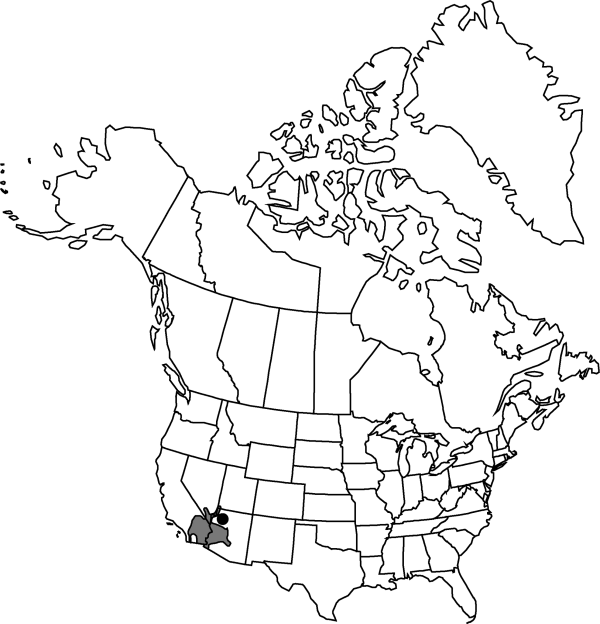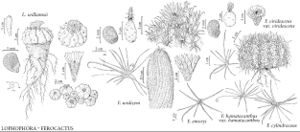Ferocactus cylindraceus
Cactography 1926(1): 5. 1926.
Stems straight, erect or nearly so (or leaning), cylindric, (20–)45–150(–300) × (20–)25–40(–50) cm; ribs (18–)21–31, shallowly notched immediately above each areole. Spines 12–32 per areole, central spines and larger radial spines whitish, yellow, pink, dull red, or brown; smallest spines per areole slender, sometimes bristlelike, less than 1 mm diam. (rarely absent); central spines 4 per areole, major rigid central spines surrounded by weaker subcentral spines; principal central spine moderately curved, sometimes twisted, usually not strongly hooked except on relatively young plants, annulate, adaxial surface usually flat or even concave, 36–140[–170] × 2–4.5 mm. Flowers maroon outside, yellow inside, 3–6 × 4–6 cm; inner tepals commonly yellow, (rarely with reddish midstripes, very rarely orange to red with a darker red midstripes); stigma lobes yellow (to red). Fruits ± readily dehiscent through basal pore, bright yellow (very rarely reddish), 30–40(–50) × 15–20 mm, leathery or fleshy, locule dry, hollow except for seeds. Seeds (1.5–)2–3 mm, pitted. 2n = 22.
Phenology: Flowering early spring–early summer (late summer–early fall).
Habitat: Interior chaparral, Mojave desert scrub, Sonoran desert scrub, usually on rocky slopes, igneous and limestone substrates
Elevation: 0-1500 m
Distribution

Ariz., Calif., Nev., Utah, Mexico (Baja California, Sonora).
Discussion
The name Ferocactus acanthodes has been widely applied to this species but was based on a small plant of unknown origin (and the original specimen lost), and is therefore ambiguous (N. P. Taylor 1979).
The vernacular name “compass barrel” is sometimes misapplied to Ferocactus cylindraceus, which grows straight up in its old age, instead of leaning as would F. wislizeni.
The varieties recognized by L. D. Benson (1982) are not consistently distinguishable.
Selected References
None.
